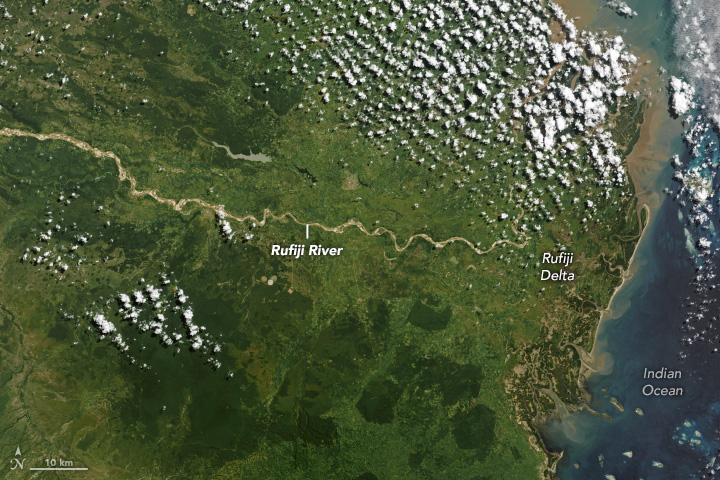
Destructive Floods Afflict Tanzania
Downloads
- tarzaniaflood_oli_20230505_lrg.jpg (4150x2767, JPEG)
- tarzaniaflood_oli2_20240429_lrg.jpg (4150x2767, JPEG)
- tarzaniaflood_tmo_20240429.mp4 (MPEG)
Metadata
- Sensor(s):
- Landsat 8 - OLI
- Landsat 9 - OLI-2
- Terra - MODIS
- Data Date: May 5, 2023 - April 29, 2024
- Visualization Date: May 1, 2024
While southern Africa experienced a prolonged dry spell, heavy rains throughout April 2024 brought severe flooding to eastern African countries, including Tanzania, Kenya, and Somalia. In Tanzania, floods and landslides contributed to hundreds of injuries, more than 150 deaths, and thousands of damaged buildings, according to reports on April 26. Heavy rains in Kenya and Somalia also produced dangerous floods, displacing tens of thousands of people and inundating croplands.
Tanzania’s Rufiji district, about 130 kilometers (80 miles) south of Dar es Salaam, was one particularly hard-hit area. Flooding left tens of thousands of people there in need of food, shelter, clean water, and healthcare. Approximately 34,000 hectares (84,000 acres) of crops were also damaged, the district commissioner said in an April 10 report.
Clouds cleared by April 29, 2024, when the OLI-2 (Operational Land Imager-2) on the Landsat 9 satellite acquired an image (above, right) of flooding along the Rufiji River and its delta. For comparison, a Landsat 8 image from May 5, 2023 (above, left), shows the Rufiji at a much lower stage. The river is prone to flooding, especially during the “long rains” from March through May. But the region received excess rainfall during both the late-2023 short rains and the 2024 long rains, leading to this extreme event.
Prior to the return of El Niño in June 2023, parts of Tanzania, Kenya, Somalia, and Ethiopia had experienced several years of drought conditions. However, El Niño tends to shift precipitation patterns to intensify rain in eastern Africa while leaving southern countries much drier than normal.
This pair of images, acquired by the MODIS (Moderate Resolution Imaging Spectroradiometer) on NASA’s Terra satellite, provides a wider view of flooding in the Rufiji River Basin. The images are false color to emphasize the presence of water. A wide network of channels fanning out into the delta is present in April 2024, while the landscape appears dry in April 2023.
Upriver, a newly constructed dam on the Rufiji holds back water in a reservoir. Construction of the Julius Nyerere Hydropower Plant began in 2019, the reservoir began filling in late 2022, and the first turbine was switched on in February 2024. As one of Africa’s largest hydropower plants, it is slated to roughly double Tanzania’s power generation capacity.
The dam and reservoir are located within the Selous Game Reserve, part of which became Nyerere National Park in 2019. Covering 50,000 square kilometers (19,000 square miles), the area is among the most expansive tracts of wilderness in Africa and is designated a UNESCO World Heritage Site. The dam is expected to alter hydrology downstream and reduce the supply of sediment to floodplains, where farmers cultivate rice, and to the delta, which supports one of the largest mangrove stands in eastern Africa.
References
- AllAfrica (2024, April 15) Tanzania: Devastating Floods, Landslides. Accessed May 1, 2024.
- NASA Earth Observatory (2024, April 23) Severe Drought in Southern Africa. Accessed May 1, 2024.
- NASA Earth Observatory (2023, November 22) Devastating Flooding in East Africa. Accessed May 1, 2024.
- The New York Times (2024, April 24) Flooding Inundates Kenya, Killing at Least 32 and Displacing Thousands. Accessed May 1, 2024.
- ReliefWeb (2024, April 30) Somalia Situation Report, 30 Apr 2024. Accessed May 1, 2024.
- ReliefWeb (2024, April 10) Tanzania: Flood - 04-2024 - Tanzania Rufiji flood #1. Accessed May 1, 2024.
- Reuters (2024, February 26) Tanzania switches on first turbine of hydro plant in World Heritage Site. Accessed May 1, 2024.
- USGS Early Warning and Environmental Monitoring Program Africa CHIRPS Data. Accessed May 1, 2024.
- Yale Environment 360 (2022, March 22) Despite Warnings, a Destructive African Dam Project Moves Ahead. Accessed May 1, 2024.
NASA Earth Observatory images by Wanmei Liang, using Landsat data from the U.S. Geological Survey and MODIS data from NASA EOSDIS LANCE and GIBS/Worldview. Story by Lindsey Doermann.
This image record originally appeared on the Earth Observatory. Click here to view the full, original record.